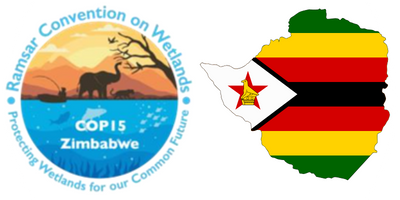Driefontein Grasslands
Dominated by a unique habitat of swamps, lakes, miombo woodlands and Kalahari desert sands, Driefontein Grasslands is home to about 85% of the total national population of the globally vulnerable wattled crane Bugeranus carunculatus and the endangered grey crowned crane Balearica regulorum. It provides an ideal breeding and feeding ground for the secretary bird Sagittarius serpentarius, saddle-billed stork Ephippiorhynchus senegalensis, African marsh harrier Circus ranivorus, and the duck species found in the Site. Other noteworthy species that depend on the Site include the black-bellied bustard Lissotis melanogaster and the kori bustard Ardeotis kori, the black-breasted snake eagle Circaetus pectoralis, and the African fish eagle Haliaeetus vocifer. Farmers use the wetlands for maize growing, small-scale farming, fishing, and cattle rearing. In 2010 the Conservation Action Plan for Wattled Crane and Grey Crowned Crane in Zimbabwe, which focused on Driefontein Grasslands, was developed to ensure the protection of the species against vlei fires and habitat loss.
Administrative region: Masvingo, Midlands, Mashonaland East Provinces
Site number: 2104
Area: 201,194 ha
Designation date: 03-05-2013
Coordinates: 19°15’S 30°46’E
Ramsar Sites
Services & More
Wetlands are vital for human survival. They are among the world’s most productive environments; cradles of biological diversity that provide the water and productivity upon which countless species of plants and animals depend for survival.
Wetlands are indispensable for the countless benefits or “ecosystem services” that they provide humanity, ranging from freshwater supply, food and building materials, and biodiversity, to flood control, groundwater recharge, and climate change mitigation.
Yet study after study demonstrates that wetland area and quality continue to decline in most regions of the world. As a result, the ecosystem services that wetlands provide to people are compromised.
Managing wetlands is a global challenge and the Convention presently counts 172 countries as Contracting Parties, which recognize the value of having one international treaty dedicated to a single ecosystem.
The Convention uses a broad definition of wetlands. This includes all lakes and rivers, underground aquifers, swamps and marshes, wet grasslands, peatlands, oases, estuaries, deltas and tidal flats, mangroves and other coastal areas, coral reefs, and all human-made sites such as fish ponds, rice paddies, reservoirs and salt pans.
Zimbabwe's Vision 2030 aims to transform the country into a middle-income economy that is prosperous, inclusive, and sustainable. Central to this vision is the recognition of the importance of natural resources, including wetlands, in contributing to the nation’s socio-economic development and environmental health. Wetlands are vital ecosystems that support biodiversity, water security, climate resilience, and the livelihoods of communities.
As part of its commitment to sustainable development and environmental stewardship, Zimbabwe has incorporated the conservation and sustainable management of wetlands into its National Development Strategy 1 (NDS1), which covers the period from 2021 to 2025. The NDS1 serves as the country’s blueprint for achieving Vision 2030 and outlines key objectives, strategies, and actions to foster economic growth, environmental protection, and social well-being.
